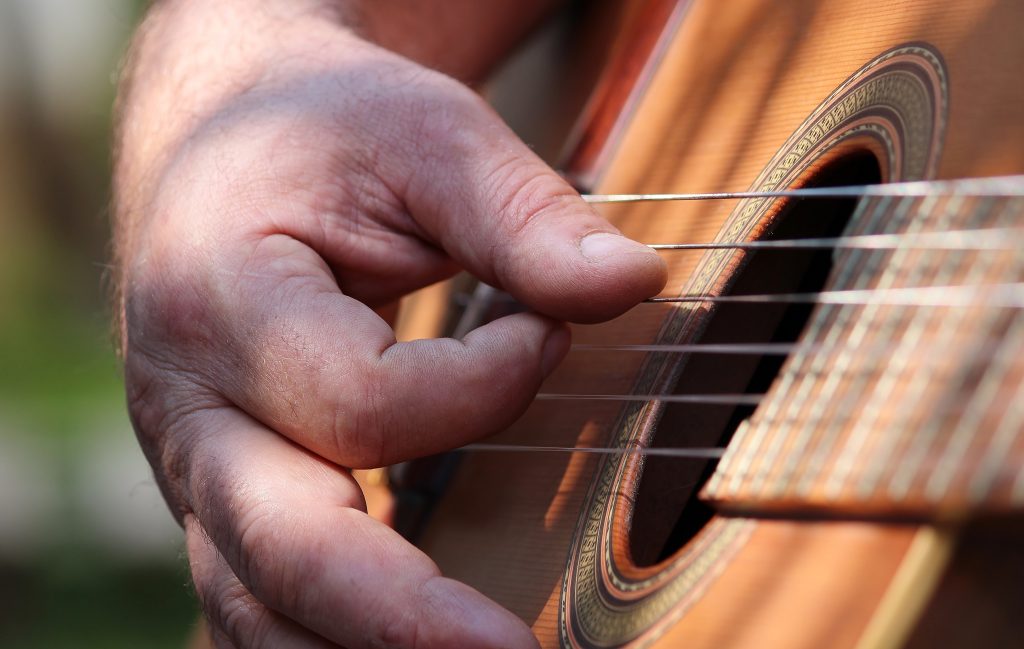All guitar chords
These are the guitar chords used the most often. From beginner to seasoned pro, any guitarist can benefit from these tables. Each note’s major, minor, and seventh chords are provided here. This tabular display of fingering dramatically enhances comprehension. If you were having trouble finding the appropriate fingering in this table, you need not worry; click the “See all” link underneath the images. If you click the link, you can learn how to play the chords depicted in the graphics for those notes, whether sharps, flats, or anything else.
How to Finger Chords
Guitar chords can be visualized on the fretboard using fingering, a notation system. Each picture places the first string (the thinnest) at the top and the sixth string (the thickest) at the bottom. Images show chords being fingered by the guitarist.
Guitar players use the numbers above the “grid” to identify individual frets.
Those red dots represent the strings that must be depressed to perform the chord.
The red line represents the bar’s reception. The index finger clamps all the strings at once, resulting in a barre. Playing chords with barrels is challenging for new guitarists, but don’t worry; it becomes easier with practice.
Ensure the guitar is in tune so the chords come out right.
Some Context to the “B” Chords
The correct representation for the note Si – H or B is often debated. Finding the solution to this issue requires looking back to the X century when the Latin alphabet was first employed to represent sounds. The terms of the letters correspond to their respective letters in the alphabet. Currently, C (Do), D (Re), E (Mi), F (Fa), G (Sol), A (La), and H (Si) make up the contemporary scale (Si). However, Si-flat (represented by the letter “B”) was once commonly used in place of Si. The A was used as the lowest pitch (La). A was for “La,” B was “Si-flat,” C was “Do,” D was “Re,” E was “Mi,” F was “Fa,” and G was “Sol.”
Now B can mean either H or Hb, and you’ll need to pick the one that sounds best.
Putting Your Fingers to Work on All Guitar Chords
Starting with basic chords is the best way to learn guitar. It’s highly improbable that you’ll ever learn every single one of the hundreds of guitar chords that are possible. However, you can get off to a good start by learning some fundamental open chords used in most popular songs. Believe it or not, you can play the most popular songs with eight open chords. You can also build on these eight chords to learn more advanced techniques.
Let’s Have Fun!
Fretting notes is one of the guitar’s most elementary parts, and the correct technique can be mastered in a day by just about anyone. Keep in mind that you can avoid permanent damage by avoiding stress. Though it’s hard to believe, guitar playing significantly contributes to many common injuries. Understanding how to fret a note correctly is crucial to your guitar-playing journey. Aside from the obvious discomfort of using the wrong technique, you also risk damaging your instrument and injuring yourself.
Good news: fretting a note is easy! It’s as simple as paying attention to five factors: thumb position, finger curvature, finger placement, and wrist angle.

The A is a major and it has 7 notes. What this means is that there are 7 chords in the A key. The A chords have a major-minor pattern, as it is with the chords of any major key.
The A major scale has 7 notes, each with a corresponding scale degree:
- Degree: 1 2 3 4 5 6 7 1(octave)
- Note: A B C# D E F# G# A
One of the important things to note when learning about the major keys is that the tones in a major key follow this sequence:
whole tone, whole tone, halftone, whole tone, whole tone, whole tone, half-tone
What this means is that there’s a halftone in the third and seventh places in the scale, while the other places have whole tones. All major keys follow this pattern.
This means that the scale of the key of A is made up of the notes A, B, C#, D, E, F#, and G#.
Although the A major is not quite as popular in classical music history as keys like the D and G, it certainly has its own place. It is considered to be the simplest key for violins and has the reputation of being the key with the fullest sound. The A key is an easy key to play in guitars and also quite easy to sing in. There is an emotional quality to the key of A that makes it popular in certain songs.